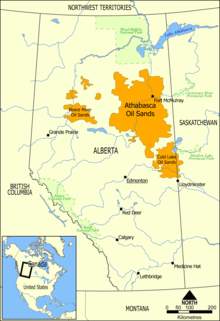
Back نفط رملي Arabic Катранени пясъци Bulgarian Sorra bituminosa Catalan Ropné písky Czech Tjæresand Danish Ölsand German Πισσώδης άμμος Greek Arenas petrolíferas Spanish Harea bituminoso EU ماسههای نفتی FA


Oil sands[a] are a type of unconventional petroleum deposit. They are either loose sands, or partially consolidated sandstone containing a naturally occurring mixture of sand, clay, and water, soaked with bitumen (a dense and extremely viscous form of petroleum).
Significant bitumen deposits are reported in Canada,[1][2] Kazakhstan, Russia, and Venezuela. The estimated worldwide deposits of oil are more than 2 trillion barrels (320 billion cubic metres).[3] Proven reserves of bitumen contain approximately 100 billion barrels,[4] and total natural bitumen reserves are estimated at 249.67 Gbbl (39.694×109 m3) worldwide, of which 176.8 Gbbl (28.11×109 m3), or 70.8%, are in Alberta, Canada.[1]
Crude bitumen is a thick, sticky form of crude oil, and is so viscous that it will not flow unless heated or diluted with lighter hydrocarbons such as light crude oil or natural-gas condensate. At room temperature, it is much like cold molasses.[5] The Orinoco Belt in Venezuela is sometimes described as oil sands, but these deposits are non-bituminous, falling instead into the category of heavy or extra-heavy oil due to their lower viscosity.[6] Natural bitumen and extra-heavy oil differ in the degree by which they have been degraded from the original conventional oils by bacteria.
The 1973 and 1979 oil price increases, and the development of improved extraction technology enabled profitable extraction and processing of the oil sands. Together with other so-called unconventional oil extraction practices, oil sands are implicated in the unburnable carbon debate but also contribute to energy security and counteract the international price cartel OPEC. According to the Oil Climate Index, carbon emissions from oil-sand crude are 31% higher than from conventional oil.[7] In Canada, oil sands production in general, and in-situ extraction, in particular, are the largest contributors to the increase in the nation's greenhouse gas emissions from 2005 to 2017, according to Natural Resources Canada (NRCan).[8]
Cite error: There are <ref group=lower-alpha> tags or {{efn}} templates on this page, but the references will not show without a {{reflist|group=lower-alpha}} template or {{notelist}} template (see the help page).
- ^ a b Cite error: The named reference
wecwas invoked but never defined (see the help page). - ^ Alberta's Oil Sands: Opportunity, Balance. Government of Alberta. March 2008. ISBN 978-0-7785-7348-7. Retrieved 13 May 2008.
- ^ "About Tar Sands". Archived from the original on 4 September 2014. Retrieved 14 May 2008.
- ^ "Bitumen and heavy crudes: The energy security problem solved?". Oil and Energy Trends. 31 (6): 3–5. 2006. Bibcode:2006OilET..31f...3.. doi:10.1111/j.1744-7992.2006.310603.x.
- ^ "What Are The Oil Sands?". Canada's Oil Sands. Calgary, AB: Canadian Association of Petroleum Producers. Retrieved 28 February 2016.
Oil sands are a mixture of sand, water, clay and bitumen. Bitumen is oil that is too heavy or thick to flow or be pumped without being diluted or heated. *** Bitumen is so viscous that at room temperature it acts much like cold molasses.
- ^ Dusseault, M. B. (12–14 June 2001). "Comparing Venezuelan and Canadian Heavy Oil and Tar Sands" (PDF). Canadian International Petroleum Conference. Proceedings of Petroleum Society's Canadian International Conference. Vol. 61. doi:10.2118/2001-061. Archived from the original (PDF) on 24 October 2011. Retrieved 4 June 2014.
- ^ "The Real GHG trend". Pembina. 4 October 2017.
- ^ "Energy and Greenhouse Gas Emissions (GHG)s". Natural Resources Canada (NRCan). 6 October 2017. Retrieved 28 January 2020.